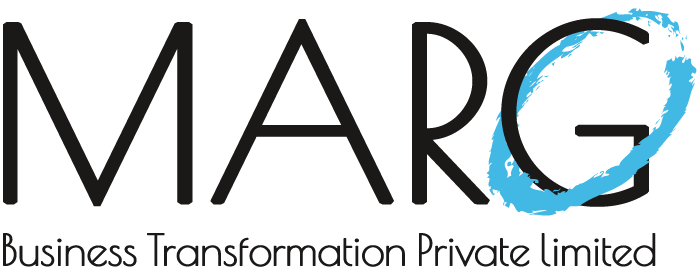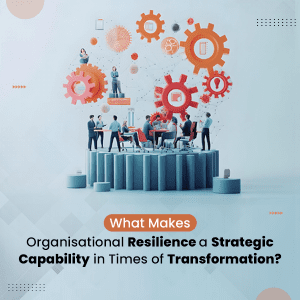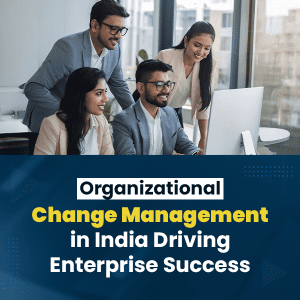
INTRODUCTION
A successful digital transformation effectively “forces” everyone involved to rewire how they work. It’s a dramatic and complex change and guiding your team through it will require knowledge and structure.
That’s where a Digital Transformation Roadmap comes in. It provides a structured path that connects business priorities with people-centered outcomes. But too often, organizations focus on platforms and technology while neglecting
people. At Marg, we believe in a People-First Digital Transformation, aligning strategy, culture, and technology so change truly sticks.
What Digital Transformation Roadmaps Are and Why They Matter
A Digital Transformation Roadmap is more than a project plan – it’s a shared blueprint for change. It defines priorities, assigns ownership, sets timelines, and measures success in both business and people terms.
With a clear roadmap:
– Executives stay aligned.
– Teams work toward common goals.
– Employees see their role in the bigger picture.
And the impact is significant. Research consistently shows that initiatives with strong change management strategy are far more likely to succeed. When roadmaps integrate people-centric change, adoption improves, resistance decreases, and transformation outcomes are sustained.
Correlation of Change Management Effectiveness With Meeting Project Objectives
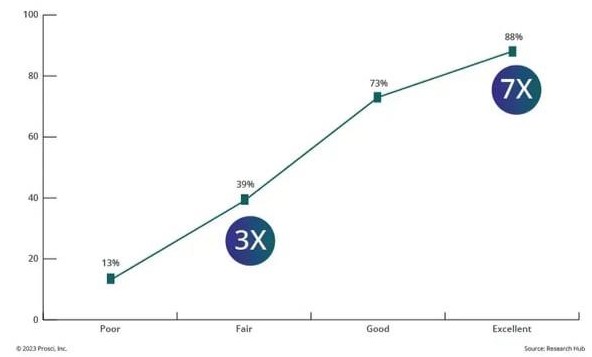
A roadmap turns that discipline into daily action by:
- Clarifying priorities so effort translates into value
- Sequencing work to prevent overload and fatigue
- Surfacing dependencies early, saving time and budget
- Tracking adoption in real time, not at go‑live
- Harvard Business Review reports that fewer than 30% of digital programs meet targets when guidance is vague. Roadmaps close that gap.
Key Components of a Successful Roadmap
At Marg, we emphasize that technology alone doesn’t drive change – people do. A strong roadmap bridges strategy with execution by integrating culture, leadership, and systems. The Prosci 3‑Phase Process transforms intent into coordinated, purposeful action. Within this structure, nine essential components drive measurable progress. Each component should be treated as a commitment – with designated ownership, tangible outcomes and a visible timeline.
1. Set a shared definition of Success
This step establishes a shared understanding of what the organization is trying to achieve, linking business goals with people-focused outcomes. Success might include improved efficiency, stronger customer experiences, or higher employee engagement.
Defining these outcomes early gives the transformation a clear destination and helps stakeholders align their efforts. Without a common definition, teams risk pursuing parallel but disconnected goals.
2. Understand Impact
Transformation affects people differently across roles, teams, and departments. This step is about identifying who will be impacted, how their work will change, and where potential challenges may arise. It uncovers hidden resistance, training needs, and cultural dynamics – information that can be used to design more targeted support.
When organizations skip this analysis, they often encounter avoidable friction that slows progress.
3. Tailored Approach
Once the vision and impact are understood, this step focuses on selecting a change management strategy that fits the organization’s culture and maturity. It provides the scaffolding for how people will be guided through the change, often using frameworks like the Prosci ADKAR Model.
A defined approach brings consistency to how change is communicated, reinforced, and supported, especially across large or complex initiatives.
Prosci ADKAR Model
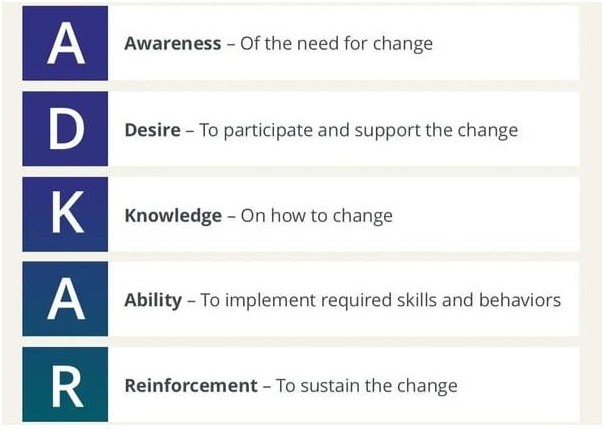
4. Combine technical rollout with people initiatives
This step integrates the technical rollout with the people side of change into one coherent roadmap. It ensures that communications, training, sponsorship activities and system deployments are timed and coordinated.
Planning in this way helps minimize confusion and ensures that people are prepared when new tools or processes go live. It also reinforces accountability and keeps momentum moving forward.
5. Track performance
Measuring success involves understanding how people are engaging with the change. This step includes tracking both system metrics (like tool usage or error rates) and human indicators (like sentiment or behavioral adoption). These insights show whether the transformation is gaining traction or stalling, and they give leaders the data needed to respond quickly and effectively.
6. Adapt actions
Even the most thoughtful plans require adjustments. This step creates space to evaluate what’s working and what needs to change based on feedback and performance data. It encourages teams to reflect regularly and respond to roadblocks with flexibility rather than force.
Organizations that build this adaptability into their roadmap become more resilient and better able to course-correct without losing momentum.
7. Review performance
Transformation efforts should be compared to initial success criteria at regular intervals. This step focuses on evaluating progress at 30, 60, and 90-day marks or other milestones that fit your context.
These reviews help sustain visibility, recognize progress, and pinpoint gaps that might otherwise go unnoticed. They also offer opportunities to reinforce behaviors and realign teams when needed.
8. Activate sustainment
Change is most vulnerable after launch, when attention shifts and old habits resurface. This step is about embedding new ways of working into everyday routines through updated documentation, continued learning or recognition of new behaviors. Sustainment keeps the change alive beyond its initial push and signals that it’s a permanent evolution, not a temporary project.
9. Transfer ownership
Eventually, the transformation must become part of how the business operates. This final step ensures that long-term responsibility moves from the project team to operational leaders who will manage and improve the new ways of working. It also reinforces that change management isn’t a one-time event, but an ongoing capability that should live within the organization.
Together, these components represent the underlying structure that helps organizations align people with purpose and navigate the emotional and cultural realities of change. Understanding what each step is for and why it matters builds the foundation for executing the roadmap with clarity and confidence.

Why Roadmaps for Digital Transformation Fail
Even with strong sustainment plans and clear ownership, digital transformations can still falter. To ensure your roadmap delivers a lasting impact, you need to know the common pitfalls and proactively avoid them.
Overemphasis on technology alone
Many organizations prioritize cutting-edge tools but neglect employee readiness. According to MIT, only half of the companies that say a strategy for AI is urgent actually have one. This needs to change: Transformation failures happen because leaders underestimate the cultural and human factors. Technology is only effective when people embrace it.
Neglect of cultural and employee adoption challenges
Stanford Social Innovation Review emphasizes that digital culture is built with intention. Effective digital transformations require “openness, participatory behaviors, and peer‑driven power,” rather than top‑down mandates. To build this culture, you can:
- Regularly assess and discuss cultural barriers
- Invest in continuous employee feedback and communication
- Create safe environments for experimenting with new behaviors
Without this, a natural reaction is employee resistance.
Lack of leadership and employee support
Without strong sponsorship and support at all levels, transformation initiatives struggle. The World Economic Forum emphasizes that successful leaders visibly demonstrate the desired behaviors, build coalitions of support, and engage employees directly. Implementing this means you should:
Ensure executives remain actively involved and visibly committed
Align digital projects clearly with business priorities
Reinforce change through direct leader communication and involvement
Ultimately, a roadmap succeeds by engaging employees to prevent resistance to change. A significant amount of resistance is avoidable, both at the employee level and higher.
Avoidable Employee Resistance and Avoidable Manager Resistance
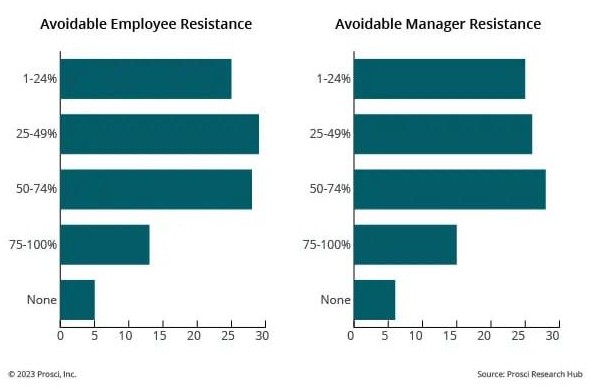
In fact, purpose-driven transformations that authentically integrate culture, leadership and technology consistently outperform competitors.
Ultimately, a roadmap succeeds only when employees are engaged and supported through people-centric change.
Create Your Customized Digital Transformation Strategy Roadmap
At Marg, we help organizations design Digital Transformation Roadmaps using proven frameworks and tailored strategies. The process includes three phases:
Prosci 3-Phase Process
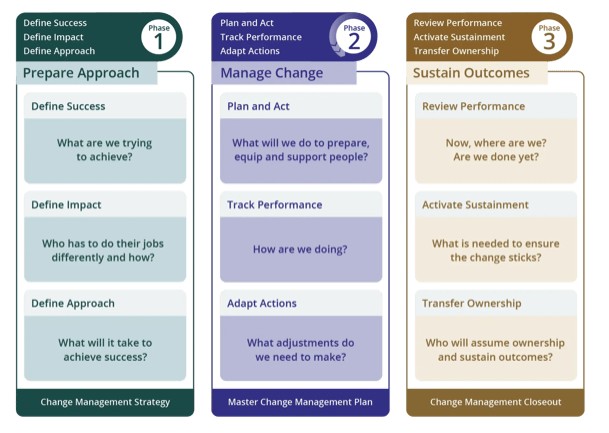
Phase 1 – Prepare Approach
Harvard Business Review warns that skipping the “walk‑before‑you‑run” stage dramatically increases failure risk. “The key to more successful digital transformation is to not skip ahead: Start with step one and invest the focus and resources to get it right.” This first phase focuses on laying a solid foundation. You’ll clarify your vision, assess who is impacted, and build a change strategy that fits your organization’s culture.
1. Define success
Write a shared definition of success with leadership and stakeholders. Use the 4 P’s Model worksheet to frame the vision, define the end state, outline the path, and clarify each person’s role. With that clarity:
Select three to five business KPIs (e.g., revenue growth, cost‑to‑serve drop)
Pair them with people-centered metrics (e.g., adoption rate, engagement uplift)
These combined indicators ensure your transformation delivers both operational value and human impact
2. Define impact
Run a readiness assessment to gauge whether a change initiative will be successful or whether additional resources and support are needed. Capture:
The most impacted groups and the scale of change for each
Key roles and responsibilities and how they might shift
Cultural factors, like speed of decision making or openness to experimentation, that could accelerate or slow adoption
Hold early interviews with frontline managers to uncover hidden resistance, training gaps, or operational constraints. Their insights often reveal friction points that surveys alone can’t detect.
3. Define approach
Choose a structured change management approach that matches your organization’s readiness and ambition. Many teams use the Prosci ADKAR Model to guide awareness-building, training, and reinforcement activities across roles.
Map specific activities to each ADKAR element. For example:
Run early Awareness campaigns through internal channels
Boost Desire with recognition programs or stretch assignments
Deliver Knowledge modules through targeted training
Write your choices into a short change management strategy to keep the whole team aligned on how people will be supported throughout the transformation.
Phase 2 – Manage change
With your strategy ready, it’s time to start making change happen. This phase focuses on activating the plan. That includes building timelines, tracking momentum and staying agile as things evolve. During this phase, communication is paramount. Keep everyone impacted informed by using a communications checklist to ensure everyone involved stays on the same page.
4. Plan and act
Develop one integrated project plan that combines the technical deliverables with change management activities in one master Change Management Plan. Anchor communications, training and stakeholder engagement to specific product or system milestones. For example:
During design freeze, host virtual demos for early feedback
At pilot launch, activate peer coaches for floor support
For enterprise rollout, record video messages from leaders acknowledging early adopters
Use a Gantt-style view to clarify timing and dependencies. Make sponsor roles visible and time-bound. This builds transparency and reinforces accountability across workstreams.
Encourage your executive sponsors to practice the ABCs of sponsorship:
- Actively and visibly participate in milestone events
- Build a vocal network of change champions
- Communicate directly with impacted groups
This helps align your process with your enterprise digital transformation methodology, increasing the likelihood of project success.
Impact of Use of a Particular Methodology on Change Management Effectiveness

5. Track performance
Monitor performance using adoption metrics (such as logins, sentiment surveys, or help desk tickets) and business outcomes (like productivity gains or error reduction).
Set up a cadence for dashboard reviews. Share a weekly snapshot through short video updates or leadership check-ins. This keeps momentum visible and allows for proactive corrections.
6. Adapt actions
It’s essential to be agile. Conduct brief retrospectives to gather team feedback and adjust course. Involve sponsors, change agents, and project leaders in short sessions that ask three key questions.
- What’s working well?
- What’s getting in the way?
- What should we try next?
Use this input to fine-tune communications, update training or simplify workflows. These feedback loops turn problems into learning opportunities and build confidence in your team’s ability to adapt and thrive in uncertain situations.
Phase 3 – Sustain Outcome
Taking action does not mean the end of a change. Organizations that do not plan for reinforcement experience significantly lower change success. This final phase ensures that change is integrated into daily operations rather than a one-time initiative. It focuses on reinforcing adoption and gradually transferring ownership to long-term business executives.
Impact of Planning for Reinforcement on Project Success
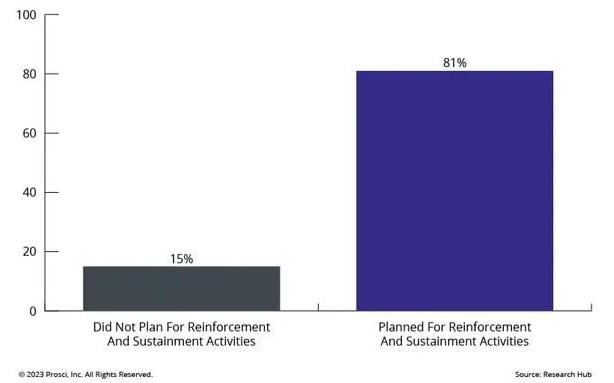
7. Review performance
Compare the outcomes to the KPIs you established in Phase 1-Prepare Approach at 30, 60, and 90 days post go-live. To determine the reason behind any gaps, consult the most recent ADKAR Assessment data or feedback patterns. Next, provide targeted assistance, like focused coaching or refresher training.
8. Activate sustainment
Integrate new habits into your daily routines to help them stick. You may :
- Update SOPs, job aids, and quick reference tools.
- Schedule quarterly microlearning refreshers.
- Create a dedicated channel for employees to share tips and celebrate wins.
These mechanisms keep knowledge current and prevent reversion to legacy practices.
9. Transfer ownership
Once performance has stabilized, assign responsibility to operational leaders.
Hold a formal transition meeting to review sustainment activities, clarify escalation paths, and confirm who will own what is moving forward.
Provide a simplified handoff playbook outlining success criteria and key responsibilities.
This emphasizes the importance of change management as a continuous process. It’s a part of how the organization works.
When your roadmap is designed in this manner, with both strategy and execution working together, you create a transformation process that is practical, adaptable, and truly people-first.
A People-First Approach for Successful Transformations
Technology may ignite transformation, but people-first digital transformation ensures success. Employees must feel prepared, supported, and connected to the change.
At Marg, we combine research-backed models like ADKAR® with our own expertise in leadership coaching, cultural transformation, and change management transformation. This blend allows us to design roadmaps that are both structured and human-centered.
With a People-Centric Change approach, organizations don’t just survive transformation – they thrive in it.
Marg Perspective
At Marg Business Transformation, we believe the strongest roadmaps balance strategy, culture, and technology – with people at the heart.
- We help organizations co-create tailored digital transformation roadmaps.
- We integrate leadership, culture, and change management strategy for adoption that lasts.
- We empower transformation leaders with frameworks, coaching, and practical tools to accelerate outcomes.
Ready to design a People-First Digital Transformation that sticks? Let’s build your customized roadmap together. Connect with Marg to turn change into sustainable growth.
